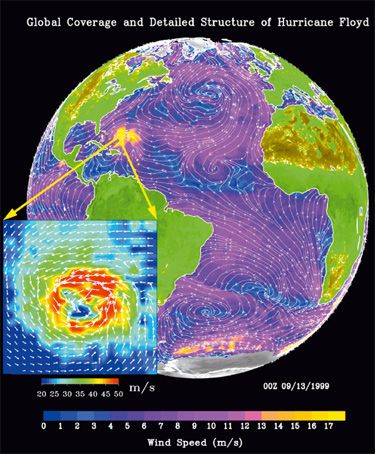Description
A scatterometer transmits radar pulses and receives backscattered energy, the intensity of which depends on the roughness and dielectric properties of a particular target. Scatterometers were originally designed to measure oceanic surface winds, where the amount of backscatter depends on two factors – the size of the surface ripples on the ocean, and their orientation with respect to the propagation direction of the pulse of radiation transmitted by the scatterometer. The first is dependent on wind stress and hence wind speed at the surface, while the second is related to wind direction. Hence measurements by such scatterometers may be used to derive both wind speed and direction.
These instruments aim to achieve high accuracy measurements of wind vectors (speed and direction) and resolution is of secondary importance (they generally produce wind maps with a resolution of order 25-50km). Because scatterometers operate at microwave wavelengths, the measurements are available irrespective of weather conditions.
Spaceborne scatterometers have provided continuous synoptic microwave coverage of the Earth for nearly a decade, starting with the ERS series, NSCAT on ADEOS, and more recently SeaWinds on QuikSCAT. The ERS and NSCAT instruments employed a fan-beam (multi-incidence) wind retrieval technique, whereas QuikSCAT employs a conically scanning (fixed incidence) technique. Increases in swath width capability of scatterometers now mean that a single instrument can provide around 90% coverage of global oceans on a daily basis.
Applications
Information from scatterometers provides a unique source of data on sea surface wind speed and direction which has important applications in weather and wave forecasting and the investigation of climate models and elaboration of marine wind climate. The assimilation of scatterometer data into atmospheric forecasting models greatly improves the description of cyclonic features which are so important in predicting future weather patterns.
Beyond the original ocean winds mission of scatterometers, a large number of new unforeseen terrestrial and sea ice applications has emerged, including: the measurement of sea ice extent and concentration; snow accumulation; regional-scale monitoring of ice shelves, rainforests and deserts. The daily global coverage of scatterometers in the polar regions and ability to discriminate sea ice, ice sheets, and icebergs, despite the poor solar illumination and frequent cloud cover of the polar regions, make them excellent instruments for large-scale systematic observations of polar ice.
Scatterometer measurements will be undertaken operationally by ASCAT on the METOP series from late 2005.
 Scatterometer data can measure the horizontal wind speed and direction over sea surfaces. NSCAT data was used in September 1999 to monitor the size and movement of Hurricane Floyd. |
 The ERS scatterometer has been used to optimize trans-Atlantic ship routing, steering ships clear of storms (in red above) |
| Current & planned instruments AMI/scatterometer Aquarius ASCAT Scatterometer (ISRO) Scatterometer (JAXA) SeaWinds |
ASCAT: www.eumetsat.de/en/area2/cgms/ap10-17.htm |